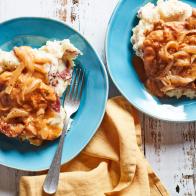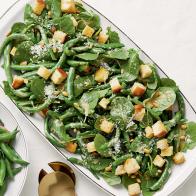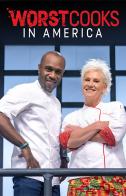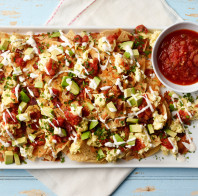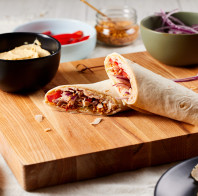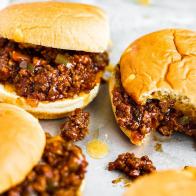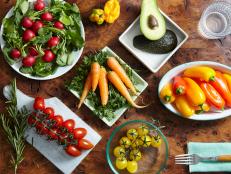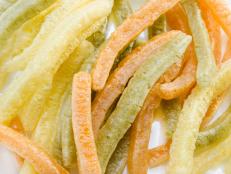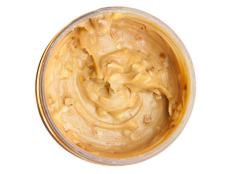11 Store-Bought Staples Nutritionists Swear By
It doesn't have to be homemade to be healthy.
Related To:
Photo By: Getty Images
Photo By: Getty Images
Photo By: Getty Images
Photo By: Getty Images
Photo By: Getty Images
Photo By: Getty Images
Photo By: Getty Images
Photo By: Getty Images
Photo By: Getty Images
Photo By: Getty Images
Photo By: Getty Images
Photo By: Getty Images
Store-Bought Staples
Everyone has a go-to store-bought item in their kitchen — even dietitians! Here’s a list of 11 items registered dietitian nutritionists (RDNs) from around the country always have on hand.
Canned Beans
Liz Weiss, MS, RDN, dietitian, family nutrition expert and host of Liz's Healthy Table podcast, is always stocked with canned beans because, "they're affordable, nutritious and versatile." In Weiss's kitchen, canned chickpeas make their way into homemade hummus, cannellini beans into Minestrone soup, pinto beans are often the star of cheesy quesadillas and smashed black beans are added to chocolate brownies. "Half a cup of beans has 120 calories, 4 grams of dietary fiber, and 7 grams protein. If sodium is a concern, choose low-sodium or no-salt-added canned beans, or drain and rinse to wash away 40% of the sodium," she says.
Oats
"Oats are my go-to pantry staple because they are nutrient-rich, shelf-stable and very versatile," says Amy Goodson, RD author of The Sports Nutrition Playbook. "From a heart and gut health perspective, oats provide beta-glucan, which is a soluble fiber that can help lower cholesterol, as well as acts as a prebiotic to feed the good bacteria in our gut. From a kitchen perspective, oats can be eaten by themselves as oatmeal or overnight oats, used as the main ingredient in energy bites and granola bars and can even be ground into flour to be used in baked goods and as a breadcrumb replacement in dishes like meatballs and parmesan chicken."
Almonds
Bonnie Taub-Dix, RDN, creator of BetterThanDieting.com and author of Read It Before You Eat It: Taking You from Label to Table, stocks up on almonds in any shape or form — sliced, slivered, whole, chopped, pureed (almond butter) and powdered (almond flour or protein powder). Taub-Dix explains that almonds, "supply a powerhouse of nutrients while also bringing a satisfying crunch that helps you feel fuller for a longer period of time." Plus, "a handful of almonds supplies 6 grams of protein (equivalent to the amount in an egg) and 35 percent of the Daily Value for vitamin E and 3 grams of fiber (13 percent of your DV for fiber) per serving and the healthy fats in almonds may help reduce cholesterol levels." Taub-Dix recommends almonds for a travel-friendly snack or an afternoon pick me up that doesn’t need to be refrigerated. You can also find some brands offering almonds in bold flavors, like sriracha or wasabi and soy flavors, to please any palate.
Eggs
Eggs are a kitchen staple for Liz Shaw, MS, RDN, CPT, nutrition media authority and author of The Air Fryer Cookbook For Dummies, thanks to their versatility and affordability. Shaw says you can serve eggs morning, noon and night and one egg costs on average $0.13! "Plus, they are packed with nutrition, with one large egg offering 6 grams of complete protein as well as a source of 8 important nutrients including choline — a B-like vitamin that nearly 90% of Americans aren't getting enough of."
Avocado Oil
Avocado oil is the go-to pantry staple in the home of Kelly Springer MS, RD, CDN, owner of Kelly's Choice, LLC in Skaneateles, New York. "Avocado oil has a smoke point of 520-degrees which is important in our house because we are always trying to cook quickly on high heat." This makes avocado oil perfect for pan searing, sauteing and grilling. "Avocado oil is also rich in healthy fats and antioxidants. Having fat, like avocado oil, helps to absorb fat-soluble vitamins like A, D, E and K," explains Springer.
Pasta
Rosanne Rust, RD and author of DASH Diet for Dummies, always has at least three pasta shapes on hand to choose from. "Pasta is enjoyed by all ages and is an easy meal to get on the table. Pasta can even reduce your food waste by being the perfect landscape for using up leftovers," explains Rust.
Canned Tomatoes
"You'll always find my pantry stocked with a variety of canned tomatoes which can be just as nutritious as fresh, given that they are picked and then canned right away at the peak of their ripeness," exclaims Malina Malkani, MS, RDN, CDN, author of Simple & Safe Baby-Led Weaning. Malkani loves how flavorful, nutrient-rich and versatile canned tomatoes, tomato pastes, and tomato sauces are and that they're a shelf-stable way to build several key nutrients into meals and snacks, including vitamin C, beta carotene, potassium, iron, and fiber. In addition, canned tomatoes in all forms provide lycopene, an antioxidant in tomatoes that becomes more easily absorbed when tomatoes are cooked prior to canning. Malkani’s tip when shopping for canned tomatoes, "look for 'low sodium,' or 'no salt added' versions to help keep sodium intake in check, especially if you are feeding an infant between the ages of 6-12 months."
Hummus
Amy Gorin, MS, RDN, a plant-based registered dietitian and nutrition partner with Sabra, says "I love Sabra's Everything Bagel Seasoned Hummus. It's a wonderful vegan food that provides satiating protein and fiber in every spoonful!" She enjoys eating it in the traditional way with crudite dippers, but she also loves adding a scoop of it as a topping to toast and eggs and as a base for pita pizzas.
Ground Flaxseed
Jenna Braddock, MSH, RD, CSSD, CPT, sports dietitian, owner of Make Healthy Easy and author of The High-Protein Vegan Cookbook for Athletes and Easy Cooking for Two, always has ground flaxseed on hand ready to add to smoothies, muffins or pancakes. "It is a source of healthy fat and powerful fiber that easily adds to a number of foods. It is a staple I use nearly daily," explains Braddock.
Canned Seafood
Canned seafood, especially tuna and salmon, are always on hand in the kitchen of Mandy Enright, the FOOD + MOVEMENT Dietitian and author of 30-Minute Weight Loss Cookbook: 100+ Quick and Easy Recipes for Sustainable Weight Loss. "I'm a huge advocate of having a source of lean protein at every meal, and seafood definitely fits that bill. However, there are some days when life gets in the way and I don’t always have time to get to the store to buy fresh proteins — that's where shelf-stable seafood comes into play." Some of Enright's favorite ways to enjoy canned seafood is to throw tuna onto salads, toss into pasta dishes and even make a classic tuna melt for a quick lunch in a pinch.
Fresh Grapes
"Grapes are a fresh staple that I like to keep on hand for snacking and adding into recipes," says Jim White RDN, ACSM ESP, owner of Jim White Fitness and Nutrition Studios and partner with Grapes from California. "Sometimes before bed, I want something sweet but I don't want the high calories and saturated fat found in many store-bought frozen treats." For these occasions, White simply pops a bowl of fresh grapes in the freezer. "Grapes are tasty, healthy and hydrating, plus they deliver beneficial polyphenols which promote antioxidant activity and support vital biological functions. They're also naturally fat- and cholesterol-free and very low in sodium, which makes them a perfect fit for a heart-healthy diet."

